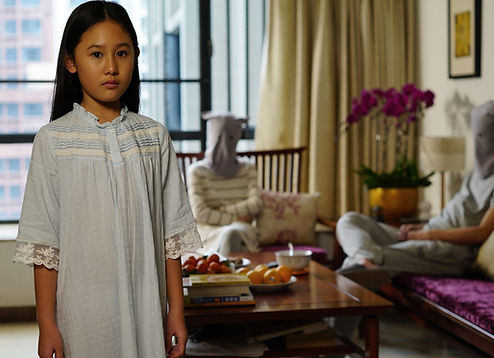umbrella
west coast exhibitions
Omer Fast
Good Riddance
6 june 2026 - 23 august 2026
opening reception on 6 june, 2-6 pm
In our summer exhibition, we are presenting two films by artist Omer Fast: De Oylem iz a Goylem and The Invisible Hand.
Both films are based on a medieval Jewish fairy tale that explores the relationship between reality and fiction, human encounters with the inexplicable, and fundamental questions about darkness, mystery, the hidden, and guilt. Drawing on the fairy tale motif, Fast is particularly interested in the way narratives are constructed and the changes stories undergo when told by different voices and from different perspectives.
In his films, the artist experiments with virtual reality and digital technologies. His films are often presented in specially designed spatial installations, where they become theatrical or cinematic productions that directly involve the audience, because the viewers themselves become part of the production and thus protagonists.
In De Oylem iz a Goylem, a lonely skier in the Salzburg mountains makes an eerie acquaintance. The film is set on a chairlift, high above a ski slope in a snow-covered ski resort in the Austrian Alps. The film was commissioned by the Salzburger Kunstverein in 2019.
The second film, The Invisible Hand, depicts a family's confrontation with a ghost in the Pearl River Delta in China. The Invisible Hand was commissioned by the Guangdong Times Museum. It was filmed in Guangzhou, China, in 2018 and premiered there in the same year, but was banned after only a few days. The official reason given was that ghosts no longer exist since the founding of the People's Republic of China and therefore such a film could not be shown.
We are delighted to be able to show these two films by the internationally renowned artist for the first time in Denmark.
Omer Fast was born in Jerusalem in 1972. He studied visual arts in Boston and New York and, since graduating in 2000, has had solo exhibitions at the Pinakothek der Moderne in Munich (2021), the Times Art Museum in Guangzhou (2018), the Martin Gropius Bau in Berlin (2016), the Jeu de Paume in Paris (2015) and the Whitney Museum in New York (2010). Group exhibitions include dOCUMENTA13 and the Venice Biennale 2011.
Fast received the Bucksbaum Prize for his work The Casting at the 2008 Whitney Biennial and the National Gallery Prize for Young Art in Berlin in 2009 for his work Nostalgia. His works are included in various international collections, including the Tate Modern in London, the Guggenheim Museum in New York and the Centre Pompidou in Paris.
I vores sommerudstilling præsenterer vi to film af kunstneren Omer Fast: De Oylem iz a Goylem og The Invisible Hand.
Begge film er baseret på et middelalderligt jødisk eventyr, der udforsker forholdet mellem virkelighed og fiktion, menneskers møder med det uforklarlige og grundlæggende spørgsmål om mørke, mystik, det skjulte og skyld. Med udgangspunkt i eventyrmotivet er Fast især interesseret i, hvordan fortællinger konstrueres, og hvordan historier ændrer sig, når de fortælles af forskellige stemmer og fra forskellige perspektiver.
I sine film eksperimenterer kunstneren med virtual reality og digitale teknologier. Hans film vises ofte i specialdesignede rumlige installationer, hvor de bliver til teatralske eller filmiske produktioner, der involverer publikum direkte, fordi seerne selv bliver en del af produktionen og dermed hovedpersoner.
I De Oylem iz a Goylem gør en ensom skiløber i bjergene ved Salzburg et uhyggeligt bekendtskab. Filmen udspiller sig på en stolelift højt over en skiløjpe i et snedækket skisportssted i de østrigske Alper. Filmen blev bestilt af Salzburger Kunstverein i 2019.
Den anden film, The Invisible Hand, skildrer en families konfrontation med et spøgelse i Pearl River Delta i Kina. The Invisible Hand blev bestilt af Guangdong Times Museum. Den blev filmet i Guangzhou, Kina, i 2018 og havde premiere samme år, men blev forbudt efter kun få dage. Den officielle begrundelse var, at spøgelser ikke længere eksisterer siden grundlæggelsen af Folkerepublikken Kina, og at en sådan film derfor ikke kunne vises.
Vi er glade for at kunne vise disse to film af den internationalt anerkendte kunstner for første gang i Danmark.
Omer Fast blev født i Jerusalem i 1972. Han studerede billedkunst i Boston og New York og har siden sin eksamen i 2000 haft soloudstillinger i Pinakothek der Moderne, München (2021), Times Art Museum i Guangzhou (2018), Martin Gropius Bau i Berlin (2016) Jeu de Paume i Paris (2015) og Whitney Museum i New York (2010). Blandt gruppeudstillingerne kan nævnes dOCUMENTA13 og Venedig Biennalen 2011.
Fast modtog Bucksbaum-prisen for sit værk The Casting på Whitney Biennalen 2008 og prisen fra Nationalgalerie für junge Kunst i Berlin 2009 for sit værk Nostalgia. Hans værker findes i forskellige internationale samlinger, blandt andet på Tate Modern i London, Guggenheim Museum i i New York og Centre Pompidou i Paris.
The exhibition is supported by Aage og Johanne Louis-Hansens Fond and by Den Jyske Kunstfond.

Omer Fast, De Oylem iz a Goylem, 2019, film projection, 24:40 min, Courtesy the artist

Omer Fast, The Invisible Hand, 2018, virtual reality film in 3D, 11:30 min, Courtesy the artist